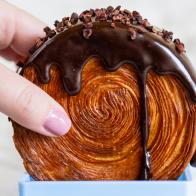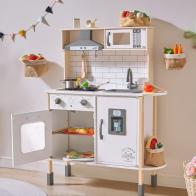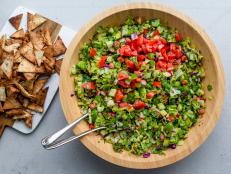Everything You Need to Know About Baklava
What makes a baklava perfect? It depends on who you ask — and where you are.
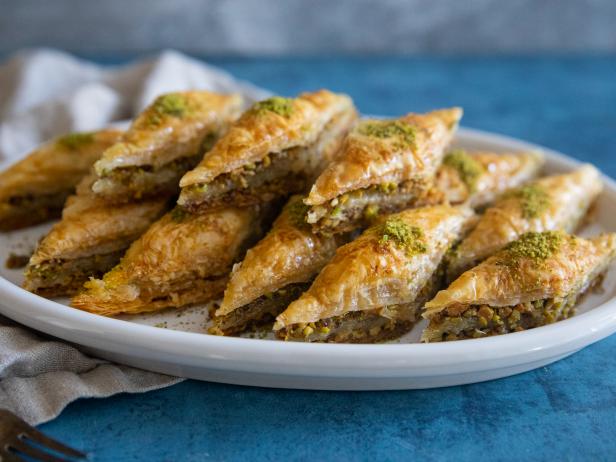
I've lived in the Middle East and Turkey for much of my life and have tasted my fair share of baklava. From Iran to Lebanon to Syria, and over to Turkey and Greece, cooks create regional variations in their own ways and with their own flavor profiles. What they have in common is that all are indulgent and, if you’re lucky, absolutely delicious.
It’s incredible to see how much variety there is within the general recipe rubric. What makes Iranian baklava different from what you might find in other parts of the Middle East is the thickness and texture of the dough and the flavor of the syrup. Iranian baklava varies from region to region, but the most popular is from Yazd, a city in central Iran known for its cultural heritage and unique pastries. Yazd baklava — or, as we call it in Iran, baghlava — is made with a homemade dough that’s slightly thicker than phyllo dough. Some add a splash of rosewater to their pastry dough, too. The filling usually consists of pistachio, walnuts and almonds plus powdered sugar and cardamon. The syrup contains rosewater and, depending on the baker, may also contain saffron.
Once the dough is ready, it’s divided into four pieces and each piece is rolled out to fit the pan. Two layers are placed in the pan and brushed with butter, then topped with nut filling that is very dense and pressed firmly. The filling is topped with the remaining two sheets and brushed with the remaining butter. Like other variations, Iranian baklava is sliced into diamonds, baked in the oven and then topped with cool syrup. The resulting texture is dense, and flavors of cardamom, rosewater and saffron shine beautifully in each bite.
While it’s common for Iranian baklava to be fudgy, other baklavas are judged by their crispness and layers. Turkish, Greek, Syrian and Lebanese baklavas are made with paper-thin phyllo dough. Bakers use anywhere from 15 to18 sheets of phyllo, and carefully brush each layer with melted butter or ghee. The syrup for each national variation is different. While Turkish baklava uses a simple syrup, Greeks use cinnamon and honey, and Lebanese syrup is infused with orange blossom water. The fillings are pretty similar, however: expect finely chopped pistachios or walnuts with just a bit of sugar.

The history of baklava spans several millennia. Some trace its origins to the 15th-century Ottoman Empire, when it was served at special occasions such as Ramadan. Others note a likely precursor to baklava in the unleavened breads stuffed with chopped nuts that were similarly prized in the Assyrian Empire in the 8th century B.C.E.
Today, inventive bakers throughout the Middle East, Turkey and Greece put their own spins on the sweet. In Turkey, there are more than a dozen varieties of baklava, many of which can be found abroad. While living in Istanbul, some of my favorites included traditional pistachio baklava and cold milk baklava — one of the trendier Turkish recipes today.
The Perfect Baklava
There are several factors that need to be taken into consideration when judging a piece of baklava, including its flavor, nuts and sweetness.
Most people will tell you that the perfect baklava has crisp layers and is not mushy at all. The key to obtaining this consistency is to wait until the syrup has cooled to pour it over the hot baklava. If the syrup is too warm, it makes the baklava soft and soggy. I recommend you prepare the syrup first, before melting the butter and assembling the pastry.
Choosing the right nuts is crucial to flavor. Only use fresh, quality nuts that are not bitter. Some people use multiple types of nuts for a mixed-nut baklava, however, I prefer to use one type of nut so the flavor shines in every piece.
Sweetness matters, too. Since the hot baklava gets drenched in syrup, there’s no need to sweeten the filling too much. The source of the sweetness depends on what type of baklava you’re making. For instance, Greek baklava syrup uses honey whereas the Turkish and Lebanese versions derive their sweetness from other ingredients. Be sure to follow the recipe when making the syrup and be mindful of how much you pour over the baklava: Too much syrup will make the baklava soggy and too little will make it dry.
We also need to discuss phyllo dough. Look for it near the puff pastry in many supermarkets, often stored in the refrigerated section. (I typically find it in the freezer at the Middle Eastern groceries where I shop.) Keep it in the fridge until you’re ready to use it. The sheets are very thin and tear easily, which is okay because you can’t really tell where the dough was torn once the baklava is assembled. When you’re ready to make the baklava, take the phyllo sheets out of the box, place them on the counter and gently unroll. Cover them with a kitchen towel to prevent them from drying out as you assemble the baklava.
Personal preferences can separate good from great baklava, whether you’re sampling sweets at a Middle Eastern bakery or rolling out phyllo dough in your home kitchen. Whatever style you prefer and wherever you are, baklava makes everything sweeter.
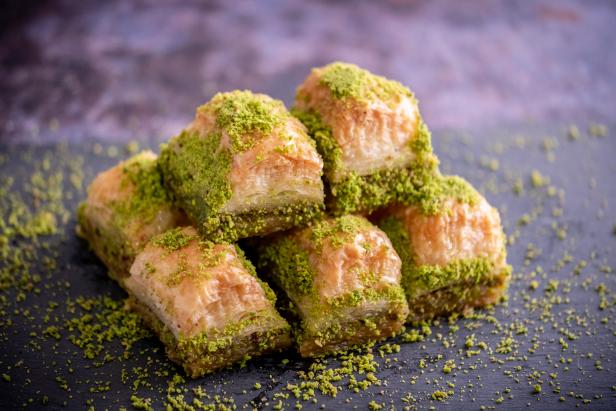
Aykut Ekinci/Getty Images
Baklava FAQs
What if your baklava doesn’t turn out as you imagined? Here are a few common questions and answers.
The syrup crystalized after I poured it over the baklava. What went wrong?
Crystallization is very common in sugar-based syrups. The best way to prevent it is to add some fresh lemon juice right before you take the syrup off the heat.
My baklava turned out soggy, not crisp. Why?
As mentioned above, the main reason for a soggy baklava is the syrup temperature. If the syrup is not cool enough when you pour it over the pastry, the baklava will be soggy.
How can I store leftover baklava?
The best way to store baklava is to place it in an airtight container and keep it at room temperature. Baklava keeps for up to 3 days at room temperature and a week in the fridge.
Related Content:











